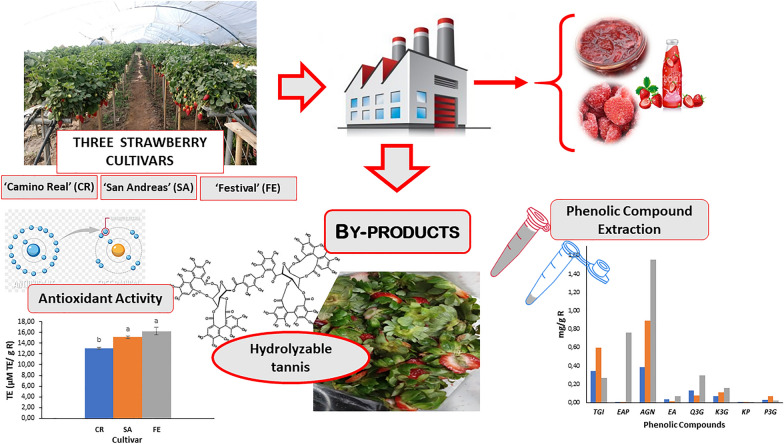- Record: found
- Abstract: found
- Article: found
Strawberry agro-industrial by-products as a source of bioactive compounds: effect of cultivar on the phenolic profile and the antioxidant capacity

Read this article at
Abstract
The post-harvest processing of strawberries generates considerable amounts of by-products that consist of the inedible parts of the fruit (sepal, calyx, stem, and non-marketable portion of the fruit), which is an environmental problem for local producers and industries. This study aimed to revalue these kinds of tissues through identifying and quantifying the genotype influence on the total phenolic content, phenolic profile, and the antioxidant activity of the by-products from three strawberry cultivars: ‘Festival’ (FE), ‘San Andreas ‘ (SA), and ‘Camino Real’ (CR). The total phenolic content was determined by the Folin–Ciocalteu method, in-vitro antioxidant activity by the DPPH* radical scavenging method and the phenolic profile by PAD–HPLC. The different genotypes showed significant differences ( p < 0.05) in total phenolic content (TPC), FE being the one with the highest TPC (14.97 g of gallic acid equivalents < GAE > /Kg of by-product < R >), followed by SA and CR cultivars. The antioxidant capacity of the SA and FE tissues were similar ( p > 0.05) and higher (15.1–16.3 mmol Trolox equivalents < TE > /Kg R) than CR. Eight main phenolic compounds were identified and quantified on the three cultivars. Agrimoniin was the principal polyphenol (0.38–1.56 g/Kg R), and the cultivar FE had the highest concentration. This compound showed the highest correlation coefficient with the antioxidant capacity ( R 2 0.87; p < 0.001). This study highlighted the impact of the multi-cultivar systems in strawberry production on the bioactive potential and the diversity of secondary metabolites obtained from strawberry agro-industrial by-products at a low cost.

Related collections
Most cited references43
- Record: found
- Abstract: not found
- Article: not found
Ellagitannins, ellagic acid and their derived metabolites: A review about source, metabolism, functions and health

- Record: found
- Abstract: found
- Article: found